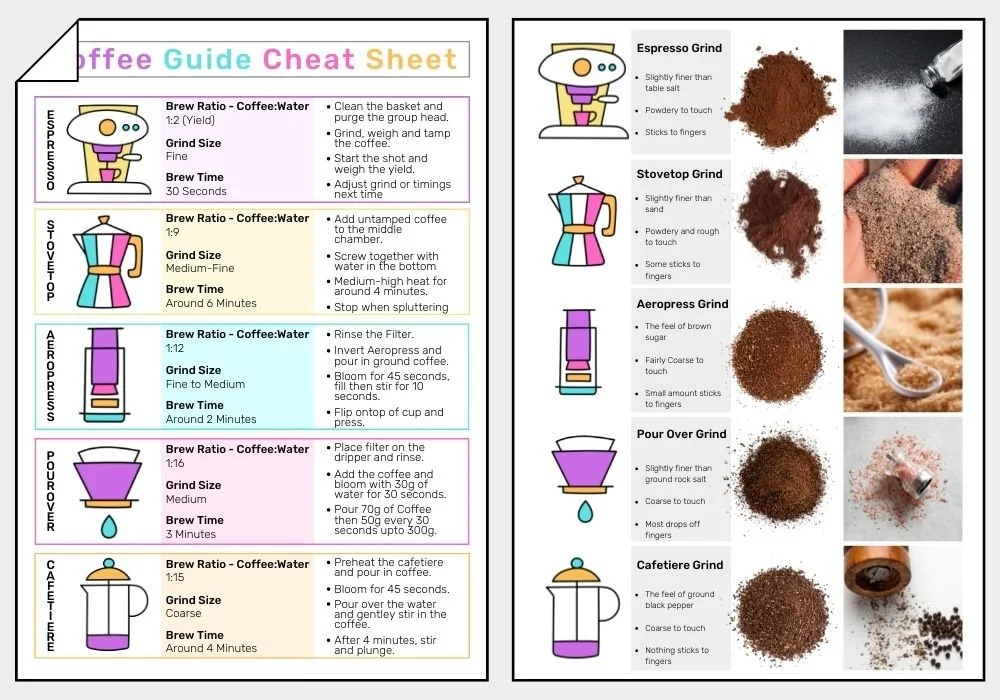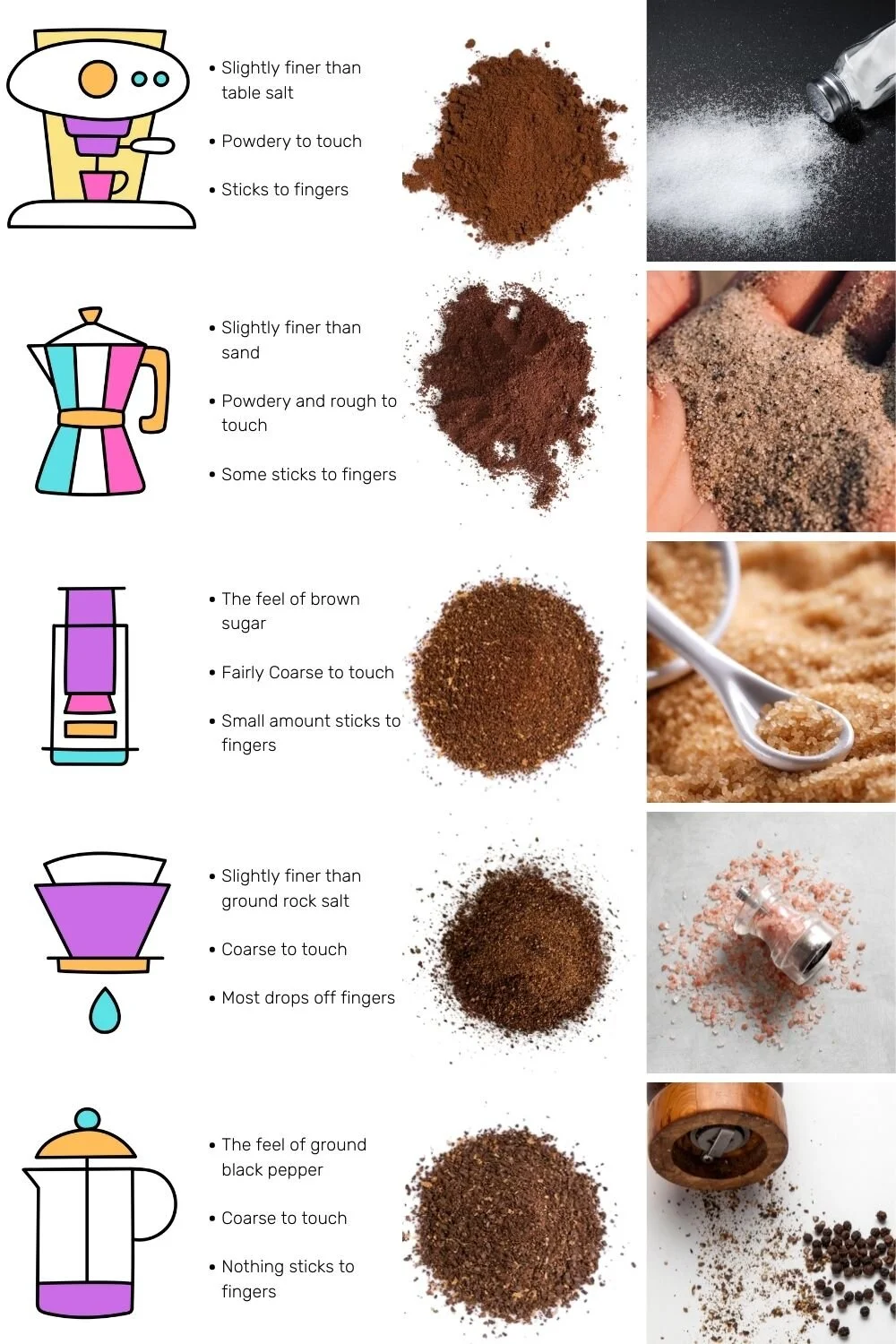How To Grind For Pour Over Coffee?
Pour Over coffee is a cruel mistress.
Watching a barista gently pour water over a bed of coffee grounds may look easy.
I can guarantee however that the recipe has been refined for that particular coffee and each variable has been tweaked to brew the perfect coffee.
Pour over grind size is certainly something that troubles many home baristas.
Coffee Grind Size Cheat Sheet PDF
Coffee shops have volume, this helps them craft the best recipe for each coffee and realistically higher quality tools.
But what is the best grind for pour over coffee and how do we know when with so many different coffee grinders?
Zach Wentz from Good Fika Coffee explains that with any pour over grind and brewing method, you're trying to keep the water in contact with the grounds for long enough to get out just the right amount of extraction from the beans.
What do we mean when we say extraction?
Put more simply, we are looking to impart the flavours from the roasted beans into the water.
If the water stays in contact with the grounds for too little time, you'll have a sour coffee. Too long, the coffee will be bitter and dry out your mouth.
If you nail it you’ll end up with a well balanced cup of delicious coffee.
The overall flavour of the coffee will depend on factors such as processing, varietal, altitude, roast level and so on. Each one contributes to a flavour spectrum from light, floral and citric through to dark, chocolatey and smokey.
Wentz continues that it’s not just how long you brew the coffee for, but also the size of the grounds.
Large, coarse grounds have less surface area than smaller, finer grounds.
The less surface area you have, the more time you need to brew to draw out these flavours from your grounds.
This is why we grind so finely with espresso, because our brew time is 20-30 seconds, we want a lot of surface area (finer grounds) so we can extract all those flavors out of our coffee.
With pour over, our typical range of brew times is 2-4 minutes, depending on your recipe.
Given these longer brew times, we're going to want a coarser pour over grind, decreasing the surface area, so that we don't extract too much.
Pour over is a little more complicated still, because the size of our grounds helps determine our brew time.
Our water has to go through the grounds and into the cup.
If the pour over grinds are very fine, it's going to take our water longer to go through the grounds. If our grinds are very coarse, the water will pass through the grounds too quickly.
Meaning, with pour over, we can't just say, I'm going to brew for 3 minutes.
We can stop pouring at a certain time, but the remaining brew time is determined by how much time it takes for the water to "drawdown" through our grounds (and that depends on the grind size).
This is why we can't use the very fine espresso grind level for pour over, we'll extract far too much because our water is in contact with a lot of surface area for a very long time, and the brew will taste bitter.
(That said, don't confuse espresso grind level, with an espresso roast. Espresso roasts are usually very dark, but they can be really good when brewed as a pour over, just grind for pour over instead).
To further complicate your pour over recipe, the characteristics of your roast will also change the timing and pour over grind level.
Even the amount of time that has elapsed since the roast can affect your coffee. Roasting beans involves removing moisture from the beans, this moisture once removed traps CO2 within the bean.
Over time the beans will naturally release this CO2 "off gassing" (this is why your bag of beans has that little one way valve, that valve allows the gas to escape the bag).
When you brew, pouring hot water on the grounds, you accelerate this off-gassing process.
So if your beans are fresh more gas is escaping than if they are a few weeks, or even a month old.
Roast age is just one characteristic of the roast that affects your pour over recipe, other factors include;
roast level (if it's darker it will have more CO2 content because more moisture was taken out of the bean),
whether it's a blend (many different varietals of coffee bean from different regions) or single origin (just one coffee bean variety from one region)
and bean size (not all coffee beans are the same size, for example "peaberry" are very small beans.
This is why it's important to always weigh the beans before you grind and not use a volume based approach (e.g. 1 cup of beans)).
All this to say, in any given coffee shop, you have baristas "dialling in" their roast recipe. They do this everyday and sometimes multiple times per day.
This involves starting with a base pour over grind level and a base ratio, medium grind (between fine and coarse) and 1 gram of coffee grounds for every 14 grams of water.
Then brewing with pour over, trying the coffee, and adjusting.
If the brew is sour, they grind a little more finely or use less water, to get more extraction. If the brew is too bitter or dries out their mouth, they grind a little more coarse or use more water, to get less extraction.
After they finish, they write the recipe down so the rest of the team knows. (Note: For fun, next time you go to your local coffee shop, order a pour over and see if you can find their recipe behind the counter. It's usually on a white board or clipboard somewhere kind of hidden.)
What is the best grind size for pour over coffee?
Chris Clark from BrewCoffeeHome.com says medium is the best for pour-over.
Depending on the specific manual drip coffee maker or filter you are using, medium fine and medium coarse also work.
The consistency will fall between table salt to rocky sand. The coffee grind size chart above has images of each grind size.
How can you tell the difference between a pour-over grind and other grind sizes?
Coffee brewing is all about proper extraction, Clark continues.
Many factors affect the extraction, such as grind size, brew temperature, brew time. The grind size is related to the other factors.
Coarser grinds are more suitable for immersion methods such as French press or cold brew coffee due to the longer brew time.
Espresso only extracts coffee within 30 seconds or so. Therefore, a finer grind size is better for optimal extraction in such a short brew time.
Turkish coffee, use powdery coffee grounds since it's unfiltered.
Pour over usually takes about 2 minutes. A medium grind is the best.
Do different coffee beans require different grind sizes?
Initially No, Not if you are using coffee beans for pour over, but it is also subjective to taste and experimentation explains Scott Angelo from Oceana Coffee.
As skill and palate improves then different grind size per bean can be used to bring out different nuances of different beans.
Does the roast profile require different grind sizes (darker or lighter coffee)?
This is a similar answer as above.
For the roast , the darker coffees are more open to dissolve solids so a more course grind can help with not having over extraction.
What is the best coffee to water ratio for pour over?
According to Specialty Coffee Association (SCA)'s Golden Cup Standard, the optimal coffee to water ratio is 55 grams per liter (About 1:18)
The coffee to water ratio may vary between 1:15 and 1:20, depending on the personal taste.
Can you use espresso ground coffee for pour over?
It's not recommended for two reasons describes Clark from BrewCoffeeHome.com:
1.The coffee will be easily over-extracted. Since finer coffee grounds have more contact surfaces that increase the extraction, resulting in over-extracted.
2. The water is hard to go through the fine coffee grounds and may clog the paper filter. This will increase the water contact time and also lead to over-extracted.
Does Finer Ground Coffee Make Stronger Coffee?
Technically speaking a coffee that has been extracted with finer ground coffee may be stronger from a taste perspective.
This doesn’t necessarily mean it is stronger from a caffeine perspective.
If you were to make a pour over with fine coffee, first of all it would take much longer to extract as the finely ground coffee would effectively clog up the filter paper. This means that the brew water is in contact with the coffee for longer and the brew will be over extracted and stronger tasting.
How much coffee do you grind for pour over?
It all depends on how many people you intend to serve with your pout over and the type of pour over for that matter.
However a good rule of thumb for any pour over method is roughly 17-19 grams of coffee per person.
So if you are brewing a 2 cup V60 for 2 people, I would use 36 grams of coffee.
How do you dial in grind size for pour over?
Start off by using the recommended settings on your grinder for a pour over or filter coffee.
If you are going in blind and don’t have any sort of gauge on a pour over method grind size, start off with a consistency of ground rock salt.
From here, measure out your desired dose of coffee and brew as per the pour over recipe.
You should then be able to know whether you need to make the grind finer or coarser for the next brew.
If the coffee brew takes longer than the recipe states then make the grind coarser and if it doesn’t last as long then make the grind finer.
Pour Over Grind Size Baratza Encore
If you use the Baratza Encore your grind size should be around 14-15 for pour over.
Pour Over Grind Size Wilfa Svart
If you use the Wilfa Svart your grind size should be around Aeropress for pour over.
Pour Over Grind Size Sage Smart Grinder Pro
If you use the Sage Smart Grinder Pro your grind size should be around 16-44 for pour over.
Pour Over Grind Size Baratza Virtuoso
If you use the Baratza Virtuoso your grind size should be around 13-27 for pour over.





















